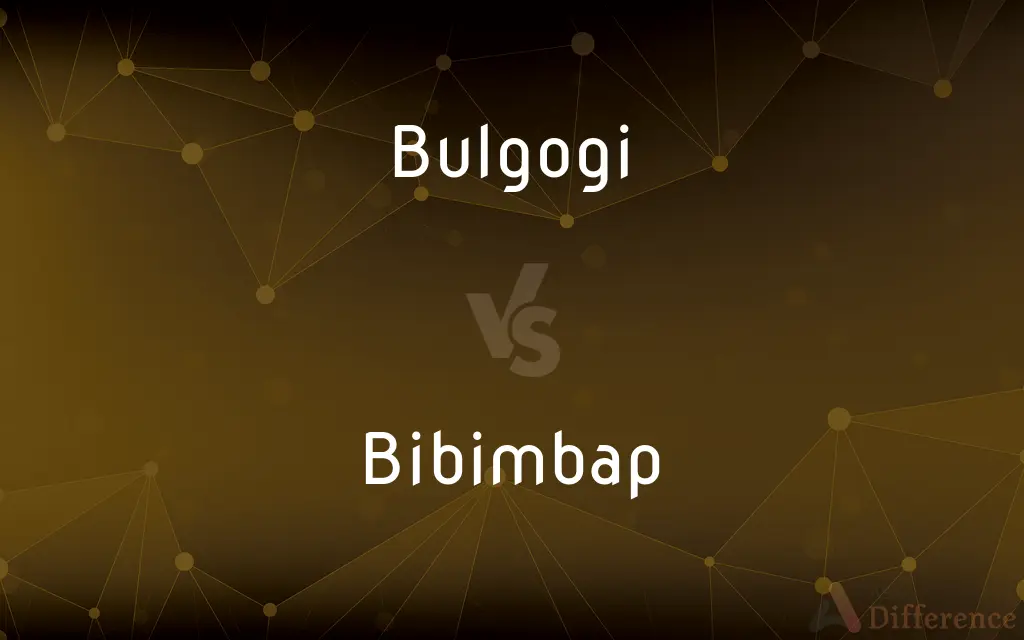Bulgogi vs. Bibimbap — What's the Difference?
Edited by Tayyaba Rehman — By Urooj Arif — Updated on July 6, 2024
Bulgogi is a Korean grilled meat dish, while Bibimbap is a mixed rice dish with assorted toppings.

Difference Between Bulgogi and Bibimbap
Table of Contents
ADVERTISEMENT
Key Differences
Bulgogi, meaning "fire meat," is a popular Korean dish made from thin slices of beef or pork that are marinated in a mixture of soy sauce, sugar, sesame oil, garlic, and other ingredients, then grilled or pan-fried. This dish is known for its tender texture and savory, slightly sweet flavor profile. On the other hand, Bibimbap is a versatile dish consisting of a bed of rice topped with a variety of ingredients, including vegetables (such as spinach, zucchini, mushrooms, and bean sprouts), a protein (often beef or tofu), a fried egg, and gochujang (Korean chili paste).
While Bulgogi focuses on the marinated meat as the centerpiece, Bibimbap is celebrated for its diversity of ingredients and the harmony of its flavors. Bulgogi can be eaten alone, with rice, or wrapped in lettuce leaves, often accompanied by side dishes called banchan. In contrast, Bibimbap combines all its components in a single bowl, making it a hearty and self-contained meal.
The preparation of Bulgogi involves marinating the meat to enhance its flavors and tenderness, followed by quick cooking on high heat to achieve a slight char while keeping the meat juicy. Bibimbap, however, requires the individual preparation of its various toppings—cooking and seasoning each separately before assembling the dish, which can be served in a regular bowl or a hot stone bowl called dolsot, which crisps the rice at the bottom.
Both dishes hold significant places in Korean cuisine but cater to different tastes and dining experiences. Bulgogi offers a rich, meat-focused experience, ideal for barbecue lovers, while Bibimbap provides a balanced meal with a variety of textures and flavors, appealing to those looking for a nutritious and customizable dish.
Cultural and historical aspects also distinguish the two. Bulgogi has a history that dates back to the Goguryeo era (37 BC–668 AD), evolving over time from a kabob-style preparation to the modern version. Bibimbap, on the other hand, is believed to have origins in royal cuisine, later becoming a way to use leftover side dishes before the Lunar New Year. Today, both dishes are staples in Korean households and restaurants worldwide, representing the rich culinary traditions of Korea.
ADVERTISEMENT
Comparison Chart
Main Ingredient
Marinated beef or pork
Rice with assorted toppings
Flavor Profile
Savory, slightly sweet, smoky
Balanced, with spicy, savory, and fresh notes
Serving Style
Often with side dishes or lettuce wraps
Mixed in a bowl, sometimes served in a hot stone bowl
Preparation
Marinated and grilled or pan-fried
Ingredients cooked separately and assembled
Cultural Origin
Goguryeo era, evolved from kabob-style cooking
Royal cuisine origins, popularized for its versatility
Compare with Definitions
Bulgogi
A Korean dish of marinated and grilled beef or pork.
For dinner, they enjoyed bulgogi with a side of kimchi.
Bibimbap
A mixed rice dish with vegetables, protein, and a spicy sauce.
For a balanced meal, he chose bibimbap, appreciating its variety of toppings.
Bulgogi
Known for its marination which includes soy sauce, sugar, and sesame oil.
The secret to their bulgogi's flavor was a special marination process.
Bibimbap
Includes gochujang, which adds a unique spicy and slightly sweet flavor.
She added an extra spoonful of gochujang to her bibimbap for more heat.
Bulgogi
Eaten with rice or wrapped in lettuce leaves with garlic and ssamjang.
She wrapped the bulgogi in a lettuce leaf, adding a slice of garlic and a dab of ssamjang.
Bibimbap
Can be customized with preferred vegetables and protein.
He ordered bibimbap with extra mushrooms and tofu instead of beef.
Bulgogi
Served often in Korean BBQ restaurants as a signature dish.
The restaurant is famous for its authentic bulgogi.
Bibimbap
Often served as a colorful presentation before being mixed.
The bibimbap arrived at the table vibrant with colors, inviting her to mix it.
Bulgogi
Can be cooked at the table on a grill, enhancing the dining experience.
They cooked bulgogi at the table, enjoying the meal's interactive aspect.
Bibimbap
Sometimes served in a dolsot, a hot stone bowl that crisps the rice.
The dolsot bibimbap had a delightful crispy rice bottom.
Bulgogi
Bulgogi (불고기; bool-GOH-gee; from Korean bul-gogi [pul.ɡo.ɡi]), literally "fire meat", is a gui (구이; Korean-style grilled or roasted dish) made of thin, marinated slices of beef or pork grilled on a barbecue or on a stove-top griddle. It is also often stir-fried in a pan in home cooking.
Bibimbap
Bibimbap ( BEE-bim-bap, from Korean 비빔밥 [pi.bim.p͈ap̚], literally "mixed rice"), sometimes romanized as bi bim bap or bi bim bop, is a Korean rice dish. The term "bibim" means mixing rice (burned rice at the bottom of the dish and cooked rice), while the "bap" noun refers to rice.
Bulgogi
A Korean dish made from sliced beef that has been marinated in soy sauce, sesame oil, garlic, sugar, and other ingredients and grilled, usually eaten by wrapping the meat and accompanying condiments with lettuce leaves into bite-sized morsels.
Bibimbap
A Korean dish of rice topped by cooked, seasoned vegetables such as spinach, carrots, and mushrooms, and often red pepper paste, sliced beef or other meat, and a raw or fried egg. The ingredients are mixed together by the diner before eating, often in a hot stone bowl.
Bulgogi
A Korean dish of shredded (usually marinated) beef with vegetables.
Bibimbap
A Korean dish of white rice topped with vegetables, beef, a whole egg, and gochujang (chili pepper paste).
Bulgogi
(by extension) Any of various Korean dishes of grilled meat in this style.
Bulgogi
The meat in these dishes, traditionally grilled at the table.
Common Curiosities
What is the significance of the egg in Bibimbap?
The egg adds richness and texture, and when mixed, it coats the other ingredients, enhancing the dish's flavor.
How should Bulgogi be cooked for the best flavor?
It should be cooked on high heat for a short time to achieve a slight char without overcooking.
Is Bulgogi typically spicy?
Not usually, but spicy versions can be made by adding gochujang or other chili sauces to the marinade.
Can I use chicken in Bulgogi?
Yes, chicken bulgogi is a popular variation, marinated and cooked in the same style as beef or pork.
What makes Bulgogi unique among other grilled meats?
Its unique flavor comes from a sweet and savory marination, which caramelizes during grilling.
Is Bibimbap eaten cold or hot?
It's typically served hot, especially when served in a dolsot, but ingredients like vegetables can be at room temperature.
What's a good side dish for Bulgogi?
Kimchi, pickled radishes, and cucumber salad complement the flavors of bulgogi well.
Can Bibimbap be made vegetarian?
Yes, by substituting meat with tofu or just using a variety of vegetables.
What are common vegetables in Bibimbap?
Spinach, bean sprouts, zucchini, carrots, and mushrooms are commonly used.
How important is gochujang in Bibimbap?
Gochujang is essential for adding the characteristic spicy, umami flavor to Bibimbap.
Share Your Discovery

Previous Comparison
Exclusively vs. Only
Next Comparison
Dolostone vs. DolomiteAuthor Spotlight
Written by
Urooj ArifUrooj is a skilled content writer at Ask Difference, known for her exceptional ability to simplify complex topics into engaging and informative content. With a passion for research and a flair for clear, concise writing, she consistently delivers articles that resonate with our diverse audience.
Edited by
Tayyaba RehmanTayyaba Rehman is a distinguished writer, currently serving as a primary contributor to askdifference.com. As a researcher in semantics and etymology, Tayyaba's passion for the complexity of languages and their distinctions has found a perfect home on the platform. Tayyaba delves into the intricacies of language, distinguishing between commonly confused words and phrases, thereby providing clarity for readers worldwide.
















































